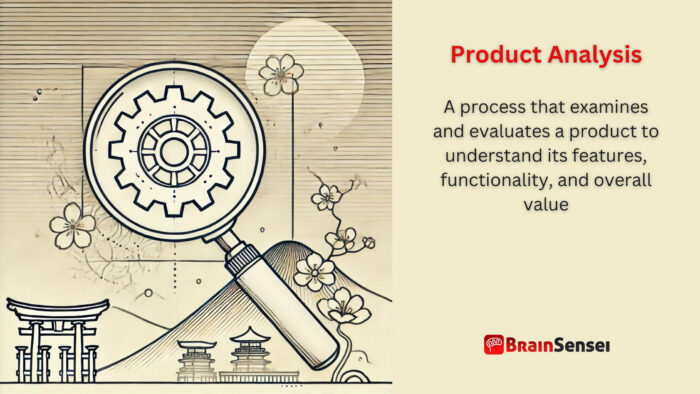
Product Analysis
What is Product Analysis?
Product analysis examines and evaluates a product to understand its features, functionality, and overall value. This process helps teams align the product with customer needs, project goals, and market requirements in project management.
Key Takeaways
- Provides insights into product features, performance, and potential improvements
- Helps align project deliverables with customer needs and expectations
- Informs better decision-making through structured evaluation
- Supports innovation by identifying market gaps and opportunities
Understanding Product Analysis
How It Works
Product analysis involves several key steps:
- Requirement Analysis: Identifying what the product needs to achieve.
- Feature Evaluation: Assessing functionalities and comparing them to customer expectations.
- Market Comparison: Analyzing similar products in the market.
- Performance Testing: Evaluating product performance under various conditions.
- Feedback Integration: Gathering and incorporating user feedback.
Notes
- Requires collaboration between stakeholders for accurate insights
- Should be conducted periodically for continuous product improvement
- Involves both qualitative and quantitative data analysis
- Must align with the project’s scope, budget, and timeline.
Related Terms
- Requirements Analysis: Focuses on gathering and understanding project and product requirements.
- Market Analysis: Examines market trends and competitor products.
- Risk Analysis: Identifies potential risks associated with the product.
- Performance Analysis: Evaluates how well the product meets performance benchmarks.
- Stakeholder Analysis: Examines the influence and interests of people involved with the product.
Examples of Product Analysis in Different Industries
Manufacturing Industry
A car manufacturer conducts product analysis to evaluate a new car model’s fuel efficiency, safety features, and customer satisfaction. Through this process, the company identifies a need for enhanced safety mechanisms, leading to design modifications that improve market competitiveness. The team uses tools like failure mode and effects analysis (FMEA) to predict potential issues and enhance product reliability. Additionally, engineers conduct competitive benchmarking to compare features with rival models, providing insights into innovative trends and consumer preferences. Customer surveys and feedback sessions highlight potential improvements, such as enhanced infotainment systems and ergonomic design adjustments.
The results from the product analysis lead to the introduction of advanced driver-assistance systems (ADAS), positioning the vehicle competitively in the market. This meticulous approach ensures efficient allocation of production resources while minimizing costly design errors.
IT & Software Industry
A software development team analyzes a new application to assess user interface design, functionality, and performance. Based on the analysis, the team refines features to enhance user experience and address performance bottlenecks. The process begins with gathering requirements from stakeholders and conducting usability tests with target users. Tools like heat maps and A/B testing platforms help identify areas of friction within the interface.
The team discovered that users frequently abandon the application during the checkout process. Further analysis reveals that complex navigation and slow load times are the primary causes. As a result, developers streamline the checkout process, simplify the user interface, and optimize the app’s performance. Post-implementation metrics show a 25% increase in conversion rates and higher customer satisfaction scores.
Telecommunications Industry
A telecom provider conducts product analysis on a new mobile device to evaluate call quality, battery life, and customer feedback. The results lead to hardware improvements and software updates to meet customer expectations. The analysis starts with extensive network performance tests in different environments, including urban, suburban, and rural areas.
Customer feedback reveals dissatisfaction with call clarity in high-density areas. Engineers then optimize signal processing algorithms and enhance the antenna design to address this issue. Additionally, battery performance tests identify inefficiencies in power consumption during video streaming. The team deploys firmware updates to improve battery life without compromising performance.
The company also conducts a comparative market analysis to benchmark its device against competitors. The insights gathered inform future product development, including 5G capabilities and AI-based camera enhancements.
These industry-specific examples illustrate the critical role of product analysis in guiding product improvements, optimizing resources, and ensuring customer satisfaction.
Use Cases of Product Analysis
United States (E-commerce)
An e-commerce company in the U.S. uses product analysis to assess the performance of its mobile app. The team identifies issues with the checkout process, leading to interface redesigns that boost conversion rates by 15%. The process involves conducting usability tests, analyzing customer feedback, and benchmarking against competitors. The team discovered that customers often abandoned their carts due to complicated navigation. The company sees a significant improvement in user engagement and sales by streamlining the interface and introducing predictive search features.
The analysis also reveals that specific product descriptions lack clarity, causing potential buyers to hesitate. Implementing more detailed explanations and interactive product visuals increased customer satisfaction scores by 20%. Regular product analysis helps the company adapt to evolving customer preferences and maintain its competitive edge.
Germany (Automotive)
A German automaker analyzes its electric vehicle’s battery performance and customer feedback. The findings guide improvements in charging efficiency and driving range. The team conducts performance tests across various terrains and weather conditions to simulate real-world usage. They also gather insights through customer surveys and telematics data.
The analysis reveals that battery performance degrades more rapidly than expected in colder climates. Engineers collaborate with battery suppliers to develop a new temperature management system, enhancing performance consistency. Additionally, market research identifies a growing demand for faster charging solutions. The automaker responds by introducing next-generation charging technology, reducing charging time by 30%.
After the analysis, the company launched a customer awareness campaign to educate users on optimal charging practices. This proactive approach addresses performance concerns and fosters brand loyalty.
Japan (Consumer Electronics)
A Japanese electronics company evaluates the functionality and market response of a new smart home device. The analysis results in firmware updates that improve device connectivity. The company also employs data analytics to track usage patterns and identify common pain points.
Initial findings show that users frequently experience connectivity issues with Wi-Fi networks. Engineers conducted root cause analysis and identified compatibility issues with certain routers. They then rolled out firmware updates to enhance connectivity and stability. Furthermore, customer feedback highlighted a demand for voice assistant integration. The development team added compatibility with popular voice assistants, significantly boosting product appeal.
The product analysis process also includes a competitive analysis to identify emerging trends. The company decides to invest in AI-driven features, positioning the device as a leader in the smart home market.
These diverse use cases demonstrate how product analysis drives innovation, improves customer satisfaction, and ensures market relevance across different industries and regions.
Best Practices for Product Analysis
Practical product analysis requires adherence to proven best practices that ensure the process yields accurate, actionable insights. Here are key practices for success:
Establish Clear Objectives
Define the goals and scope of the product analysis from the outset. Clear objectives help guide the analysis process and ensure alignment with project goals.
Engage Cross-Functional Teams
Involve stakeholders from different departments, such as marketing, engineering, and customer support. Diverse perspectives contribute to a more comprehensive analysis.
Leverage Data Analytics Tools
Utilize advanced analytics tools to collect, process, and analyze product-related data. Tools like Power BI, Tableau, and Google Analytics provide valuable insights into performance and customer behaviour.
Focus on Customer Feedback
Customer feedback is a critical component of product analysis. Use surveys, interviews, and online reviews to understand user needs and experiences.
Conduct Competitive Benchmarking
Analyze competitor products to identify market trends and potential differentiators. Competitive benchmarking helps position the product more effectively in the market.
Regularly Update Product Analysis Techniques
As technologies and market conditions evolve, so should the methods used in product analysis. Stay updated on industry best practices and emerging tools.
Document Findings and Insights
Maintain detailed records of the analysis process, findings, and recommendations. Proper documentation supports knowledge transfer and informed decision-making.
Integrate Insights into Product Development
Product analysis findings should directly influence design, development, and marketing strategies. Establish processes to ensure insights translate into actionable improvements.
By following these best practices, project managers can enhance product quality, optimize resource allocation, and better meet customer expectations.
Common Mistakes and Issues in Product Analysis
Conducting product analysis can present challenges that lead to inaccuracies, inefficiencies, or missed opportunities if not appropriately addressed. Here are some common mistakes and their implications:
Neglecting Customer Feedback
Customer feedback provides valuable insights into product performance and user experience. Ignoring this feedback can result in products that fail to meet market expectations. For example, a technology firm launched a new software platform with cutting-edge features but overlooked consistent customer complaints about a confusing interface. This oversight led to high churn rates and costly rework post-launch.
Insufficient Market Research
Failing to analyze competitors and industry trends can cause companies to miss opportunities or produce outdated products. One company introduced an innovative checkout system in the retail sector without benchmarking against industry leaders. As a result, they implemented features that were no longer relevant and lost market share to more adaptive competitors.
Overreliance on Historical Data
While historical data offers insights into past performance, relying solely on it can lead to flawed predictions. Markets evolve, and customer preferences shift. For example, an automotive manufacturer prioritized traditional fuel engines based on historical sales data, missing the growing demand for electric vehicles.
Lack of Cross-Functional Collaboration
Product analysis requires input from various departments, including marketing, engineering, and customer support. When these teams work in isolation, the analysis becomes incomplete or biased. A consumer electronics firm learned this the hard way when a product’s hardware capabilities were misaligned with the marketing team’s promises, resulting in customer dissatisfaction.
Ignoring Performance Metrics
Performance testing identifies product weaknesses and ensures reliability. Companies that neglect this step may face costly recalls or damage to their reputations. For example, a food processing company once released a new packaging technology without sufficient durability tests. The packaging failed during distribution, leading to widespread product spoilage and financial losses.
Inconsistent Documentation
Documenting the analysis process and findings is crucial for continuous improvement and knowledge transfer. Inconsistent or incomplete documentation hampers future product development. A healthcare equipment manufacturer faced delays in launching an updated device because the previous analysis lacked essential performance benchmarks.
By recognizing these pitfalls and adopting proactive strategies, organizations can improve their product analysis efforts’ accuracy, relevance, and effectiveness.
Frequently Asked Questions (FAQs)
What is the purpose of product analysis?
Product analysis helps understand a product’s strengths, weaknesses, and market positioning to guide improvements and strategic decisions.
How does a project benefit from product analysis?
It ensures that project deliverables meet customer expectations and align with project goals.
What tools do project teams commonly use in product analysis?
Tools like SWOT analysis, PESTLE analysis, and various performance testing software are commonly employed.
When should product analysis be conducted?
The project team should perform product analysis during product development, post-launch, and when they plan significant changes.
Who is responsible for conducting product analysis?
Project managers, product managers, and cross-functional teams typically collaborate on product analysis.
Additional Resources
Preparing for a PMI certification?
- Exam Prep Courses: PMP®, CAPM®, and PMI-ACP®
- Exam Simulators: PMP®, CAPM®, PMI-ACP®, PMI-PBA®, PMI-RMP®, PMI-SP®, PgMP®, and PfMP®
- Professional Development Units (PDUs): 15, 30, and 60 PDU Bundles



